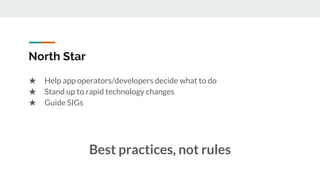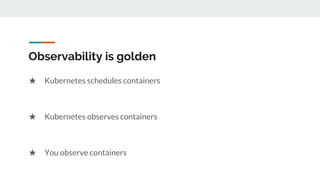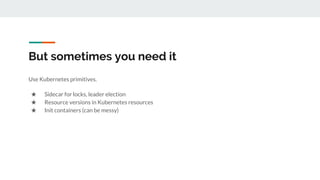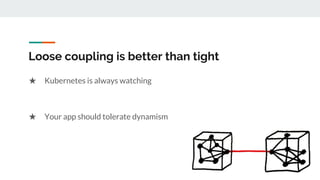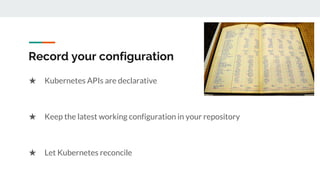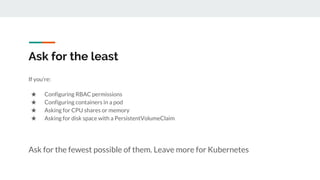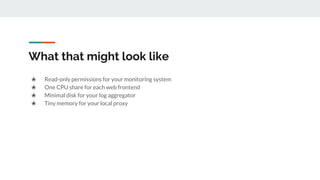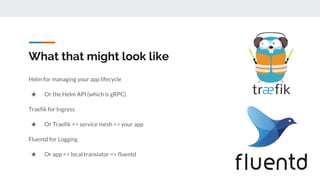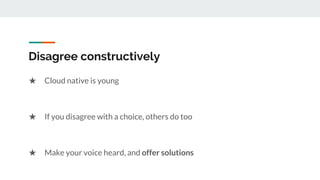The elements of kubernetes
- 1. The Elements of Kubernetes Aaron Schlesinger Microsoft Azure Containers Lead, SIG-Service-Catalog
- 2. ★ Kubernetes is growing fast ★ Usage, development, projects ★ We’re in the wild west Why we’re here
- 3. Building an app for Kubernetes Dev/Test Containerize CI/CD Staging Pre-prod Prod ResilienceMonitoring Tracing Logging Observability
- 4. Lots to figure out No one size fits all
- 5. We need a “north star” for people building cloud-native apps
- 6. ★ Help app operators/developers decide what to do ★ Stand up to rapid technology changes ★ Guide SIGs Best practices, not rules North Star
- 7. What we have now ★ Opinions ★ Evidence ★ Fragmentation
- 8. I’ve seen the good & the bad
- 9. I’m here to propose ideas
- 11. ★ Kubernetes schedules containers ★ Kubernetes observes containers ★ You observe containers Observability is golden
- 12. ★ Resource limits ★ Readiness & liveness checks ★ HPA Kubernetes observing your app
- 13. You observing your app Adopt a rich ecosystem of cloud native tools: ★ Logging ★ Service mesh ★ Tracing
- 14. When all else fails, crash
- 15. Crash-only software ★ You’ll have bugs, network outages, disk issues, etc... ★ Kubernetes is your retry loop
- 16. What that might look like ★ Your app connects to a DB on startup ★ App fails to connect, crashes ★ Tracing sees the conn. failure ★ Kubernetes restarts it ★ Monitoring, log aggregation pick up the restart ★ Alerting notifies if too many restarts ★ ...
- 17. Unordered is better than ordered
- 18. ★ Kubernetes & your app are distributed systems ★ Ordering is very hard in distributed systems ★ Try not to rely on ordering Unordered is better than ordered
- 19. Use Kubernetes primitives. ★ Sidecar for locks, leader election ★ Resource versions in Kubernetes resources ★ Init containers (can be messy) But sometimes you need it
- 20. Loose coupling is better than tight coupling
- 21. Loose coupling is better than tight ★ Kubernetes is always watching ★ Your app should tolerate dynamism
- 22. What that might look like ★ Pod => Pod messaging via Services ★ Crash if you can’t connect (crash-only) ★ Look for Kube resources via labels, not names
- 23. … But tight coupling isn’t always wrong
- 24. ★ Pods have >1 containers on purpose ★ Run tightly coupled containers in a pod Tight coupling isn’t always wrong
- 25. ★ Envoy ★ Fluentd logging driver ★ Metrics What that might look like
- 27. Record your configuration ★ Kubernetes APIs are declarative ★ Keep the latest working configuration in your repository ★ Let Kubernetes reconcile
- 28. What might that look like
- 29. Ask for the least
- 30. Ask for the least If you’re: ★ Configuring RBAC permissions ★ Configuring containers in a pod ★ Asking for CPU shares or memory ★ Asking for disk space with a PersistentVolumeClaim Ask for the fewest possible of them. Leave more for Kubernetes
- 31. What that might look like ★ Read-only permissions for your monitoring system ★ One CPU share for each web frontend ★ Minimal disk for your log aggregator ★ Tiny memory for your local proxy
- 32. Build on the shoulders of giants
- 33. Build on the shoulders of giants ★ Kubernetes provides a big API ○ … to abstract functionality that’s hard to get right ★ Maybe the community doesn’t do what you need ○ … but try to find the next best thing and build atop
- 34. What that might look like Helm for managing your app lifecycle ★ Or the Helm API (which is gRPC) Traefik for Ingress ★ Or Traefik => service mesh => your app Fluentd for Logging ★ Or app => local translator => fluentd
- 35. Parting thoughts: where should we go from here?
- 36. Who should define our guidelines? ★ I’ve started the conversation here ★ We all have a wealth of experience ★ We need to share it
- 38. We need your thoughts https://github.com/arschles/kube-best-practices
- 40. Community Extras
- 41. Pay it forward
- 42. Pay it forward ★ If you “build on the shoulders of giants,” open source it ★ You’ll be moving cloud native forward ★ We’ll progress as community & concept because of your work
- 44. ★ Cloud native is young ★ If you disagree with a choice, others do too ★ Make your voice heard, and offer solutions Disagree constructively






